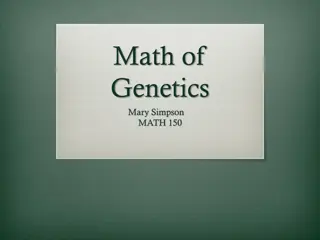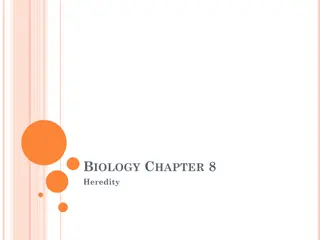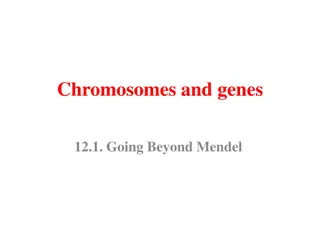Understanding Modes of Inheritance According to Mendel's Laws
Explore the fundamentals of genetics by assessing Mendel's laws of inheritance, understanding Mendelian inheritance bases, and defining various patterns of single-gene inheritance using family pedigrees and Punnett squares. Dive into the fascinating world of genotypes, Punnett squares, and laws of dominance and segregation through Mendel's groundbreaking experiments.
Download Presentation

Please find below an Image/Link to download the presentation.
The content on the website is provided AS IS for your information and personal use only. It may not be sold, licensed, or shared on other websites without obtaining consent from the author. Download presentation by click this link. If you encounter any issues during the download, it is possible that the publisher has removed the file from their server.
E N D
Presentation Transcript
Lecture Three MODE OF INHERITANCE
Objectives: By the end of this lecture, students should be able to: Assess Mendel s laws of inheritance Understand the bases of Mendelian inheritance Define various patterns of single gene inheritance using family pedigree and Punnett square
Father of Genetics Born in 1822 Monk and teacher Discovered some of the basic laws of heredity His published his work, entitled Experiments on Plant Hybrids in1866 However, largely ignored He died in 1884 with his work still unnoticed His work rediscovered in 1900.
Interpreting the outcomes of Mendels breeding experiments: The plant characteristics being studied were each controlled by a pair of factors, one of which was inherited from each parent. The pure-bred plants, with two identical genes, used in the initial cross would now be referred to as homozygous. The hybrid F1 plants, each of which has one gene for tallness and one for shortness, would be referred to as heterozygous. The genes responsible for these contrasting characteristics are referred to as allelomorphs, or alleles for short.
Punnett Square - Each parent can only contribute one allele per gene - These genes are found on the chromosomes of gametes of parents - Offspring will inherit 2 alleles to express that gene
Law of Dominance or Uniformity COMPLETE DOMINANCE - one allele is dominant to another allele RECALL MENDEL S 1stEXPERIMENT CROSS: Pure bred purple female x White male P1 generation = PP x ppFemale gametes P P Genotype ratio =1 1Pp F1 generation Phenotype ratio =1 1 purple Male gametes Pp Pp p Pp Pp p Pp purple
LAW OF SEGREGATION RECALL MENDEL S 2nd EXPERIMENT CROSS: Two F1 generation offspring with each other P1 generation = Pp x Pp Female gametes P PP p Male gametes Pp P Pp pp p Genotype ratio =1 1PP PP: :2 2Pp purple: :1 1 white Pp: :1 1pp pp white Phenotype ratio = 3 3 purple F1 generation
LAW OF INDEPENDENT ASSORTMENT DEFINITION During gamete formation, different pairs of alleles segregate independently of each other. INTERPRETATION In a dihybrid cross, each pair of alleles assorts independently during gamete formation. In the gametes, Y is equally likely to be found with R or r (that is, Y R = Y r ); the same is true for y (that is, y R = y r ). As a result, all four possible types of gametes ( Y R , Y r , y R , and y r ) are produced in equal frequency among a large population.
THE CHROMOSOME THEORY OF INHERITANCE AND SEX CHROMOSOMES How chromosomal transmission is related to the patterns of inheritance observed by Mendel?
Mendels law of segregation can be explained by the segregation of homologs during meiosis The two copies of a gene are contained on homologous chromosomes. In this example using pea seed color, the two alleles are Y (yellow) and y (green). During meiosis, the homologous chromosomes segregate from each other, leading to segregation of the two alleles into separate gametes.
Mendels law of independent assortment can be explained by the random alignment of bivalents during metaphase of meiosis I This figure shows the assortment of two genes located on two different chromosomes, using pea seed color and shape as an example (YyRr). During metaphase of meiosis I, different possible arrangements of the homologs within bivalents can lead to different combinations of the alleles in the resulting gametes. For example, on the left, the dominant R allele has sorted with the recessive y allele; on the right, the dominant R allele has sorted with the dominant Y allele.
MODES OF INHERITANCE FOR SINGLE GENE DISORDERS Autosomal Sex Linked Recessive Dominant Y Linked X Linked Recessive Dominant
Autosomal Dominant The trait (character, disease) appears in every generation. Unaffected persons do not transmit the trait to their children. Examples: Huntington disease, Myotonic dystrophy, Neurofibromatosis type 1, Marfan syndrome etc.
Family Tree of an Autosomal Dominant Mode of Inheritance Note the presence of male-to-male (i.e. father to son) transmission
Autosomal Recessive The trait (character, disease) is recessive The trait expresses itself only in homozygous state Unaffected persons (heterozygotes) may have affected children (if the other parent is heterozygote) The parents of the affected child maybe related (consanguineous) Males and female are equally affected Examples: Cystic fibrosis, Phenyketonuria, Sickle cell anaemia, Thalassaemia etc.
Punnett square showing autosomal recessive inheritance 1-) Both Parents Heterozygous: 25% offspring affected Homozygous 50% Trait Heterozygous normal but carrier 25% Normal Mother A a A AA Aa Father a Aa aa
(2) One Parent Heterozygous: A a 50% normal but carrier Heterozygous Female A AA Aa 50% Normal A AA Aa (3) One Parent Homozygous: A A Female 100% offspring carriers. a Aa Aa a Aa Aa
Family tree of an Autosomal recessive disorder Sickle cell disease (SS) A family with sickle cell disease -Phenotype Hb Electrophoresis AA AS SS
Sex Linked Inheritance This is the inheritance of a gene present on the sex chromosomes. The Inheritance Pattern is different from the autosomal inheritance. Inheritance differs in males from females.
Y Linked Inheritance The gene is on the Y chromosomes The gene is passed from fathers to sons only Daughters are not affected Hairy ears in India Male are Hemizygous, the condition exhibits itself whether dominant or recessive Father X Y* X XX XY* Mother X XX XY*
X Linked Inheritance The gene is present on the X chromosome The inheritance follows specific pattern Males have one X chromosome, and are hemizygous Females have 2 X chromosomes, they may be homozygous or heterozygous These disorders may be : recessive or dominant
X Linked Recessive Inheritance The incidence of the X-linked disease is higher in male than in female The trait is passed from an affected man through all his daughters to half their sons The trait is never transmitted directly from father to sons An affected women has affected sons and carrier daughters X - Linked Recessive Disorders: Albinism, Fragile X syndrome, Hemophilia, Muscular dystrophy, Retinitis pigmentosa
X Linked Recessive Inheritance (1) Normal female, affected male Mother X X X* X*X X*X Father Y XY XY All sons are normal All daughters carriers not affected
(2) Carrier female, normal male: Mother X* X 50% sons affected 50% daughters carriers X XX* XX Father Y X * Y XY (3) Homozygous female, normal male: - All daughters carriers. - All sons affected.
X-Linked Dominant Disorders The gene is on X Chromosome and is dominant The trait occurs at the same frequency in both males and females Hemizygous male and heterozygous females express the disease.
Punnett square showing X linked dominant type of Inheritance (1) Affected male and normal female: Mother X X Father All daughters affected, all sons normal X* X*X X*X Y XY XY (2) Affected female (heterozygous) and normal male: Mother X* X Father 50% sons & 50% daughters are affected X XX* XX Y X*Y XY
TAKE HOME MESSAGE: An accurate determination of the family pedigree is an important part of the workup of every patient Pedigrees for single-gene disorders may demonstrate a straightforward, typical mendelian inheritance pattern These patterns depend on location of the gene locus on the chromosomal, which may be autosomal or sex chromosome-linked, and whether the phenotype is dominant or recessive























